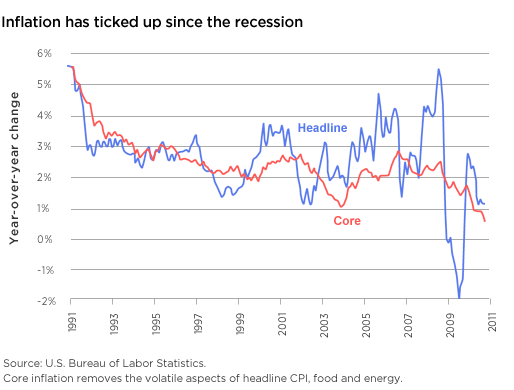The Fed’s second round of quantitative easing, known as “QE2,” was launched last fall with the primary aim of staving off deflation. Did QE2 help the U.S. economy navigate the deflation storm?
We were perilously close to a deflationary environment in the United States last summer when rates had fallen to 50-year lows. What weighed heavily on the Fed — and Chairman Ben Bernanke in particular — was that the U.S. economy might fall into a deflationary environment like the one that has stifled Japan’s economy for two decades. In the 1980s, Japan experienced rapid economic growth that ended in an economic bubble. Japan’s stock market climbed, and its real estate prices skyrocketed. Then the bubble burst, assets across the board fell in value, and Japan’s central bank did not act swiftly or strongly enough. The Fed wanted to ensure that did not happen here at home.
Why is deflation so damaging to an economy?
Deflation can have a deleterious effect, particularly if an economy is burdened with high levels of debt, as is the case in the United States today. Debt, of course, is set in nominal terms. If a company has $100,000 in debt, the burden of servicing that debt is fixed. In a deflationary environment, prices for goods and services fall, and the company’s income stream dwindles, but its debt service remains fixed. You can see how this would rather quickly result in a problem.
If some inflation is positive, what is considered an inflationary “sweet spot”?
While high rates of inflation are undesirable, some upward movement in the overall price level is necessary for a nation’s economic health. You expect prices of things like typewriters to fall, of course, because they are obsolete. But if bridges need fixing, for example, then wages for bridge-builders should increase to help attract resources from typewriter assembly to bridge repair. These adjustments in real prices are easier to accomplish if the price level as a whole is rising a bit.
In most countries where central banks target inflation, the preferred range of inflation is between 2% and 2.5%. Inflation rates in the United States today are still fairly benign, but it’s important to understand that inflationary pressures can build over time.
During the 1970s, the United States and other industrialized nations experienced “stagflation,” a pernicious combination of high inflation coupled with slow economic growth. Today, even though inflation is nowhere near the levels of the 1970s, unemployment remains high and economic growth is sluggish. Although I do not believe we are at high risk for a return to a toxic period like the 1970s, we have today what might be referred to as “stagflation light” — that is, the economy is grappling with high unemployment, weak economic growth, and nascent signs of inflation.
Now that the threat of deflation is off the table and QE2 is set to come to an end in June, what kind of leadership can we expect from the Fed going forward?
Barring any external shocks like a sharp and sustained rise in oil prices due to civil unrest in the Middle East, the best possible scenario is that the economy will enter a prolonged period of low inflation, steady growth, and an improving jobs situation. We are still not out of harm’s way, and so there is much debate within the Fed right now as to where we are headed and what the next steps might be. If the economic situation steadily improves, then you could see the Fed eventually shrink its portfolio of government bonds and return to traditional short-term interest-rate policy. But with the recovery still fragile, I do not believe that the Fed will tap the brakes by increasing short-term interest rates anytime soon.

More in: Macroeconomics



